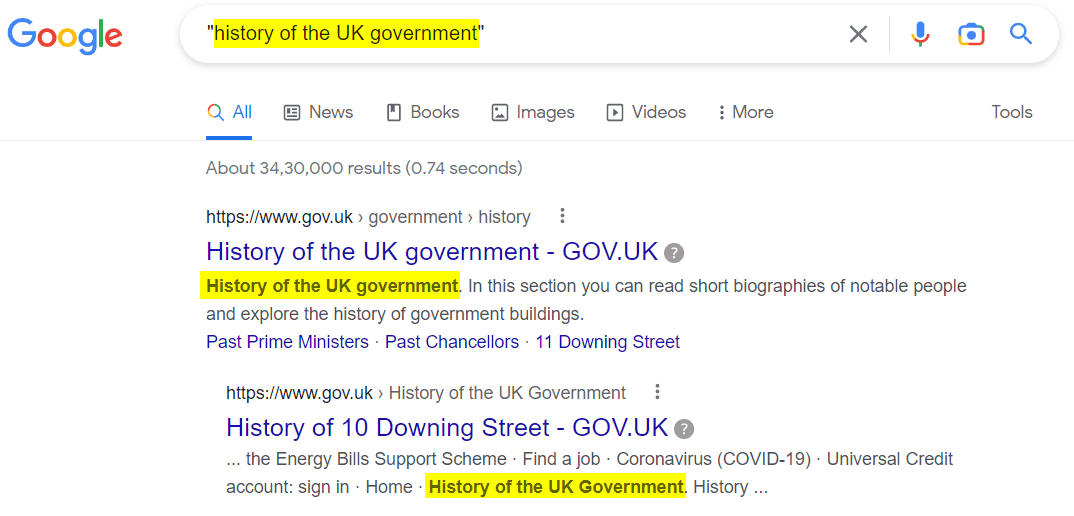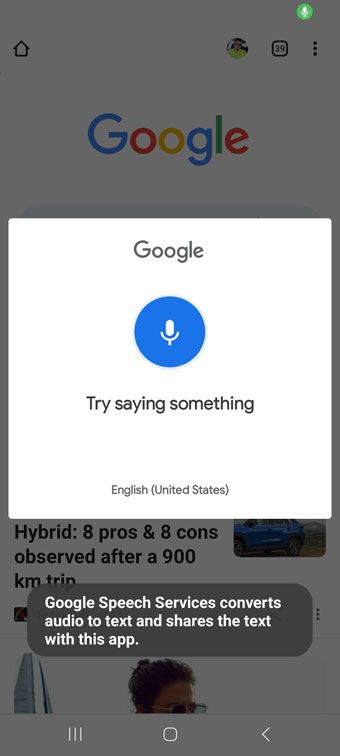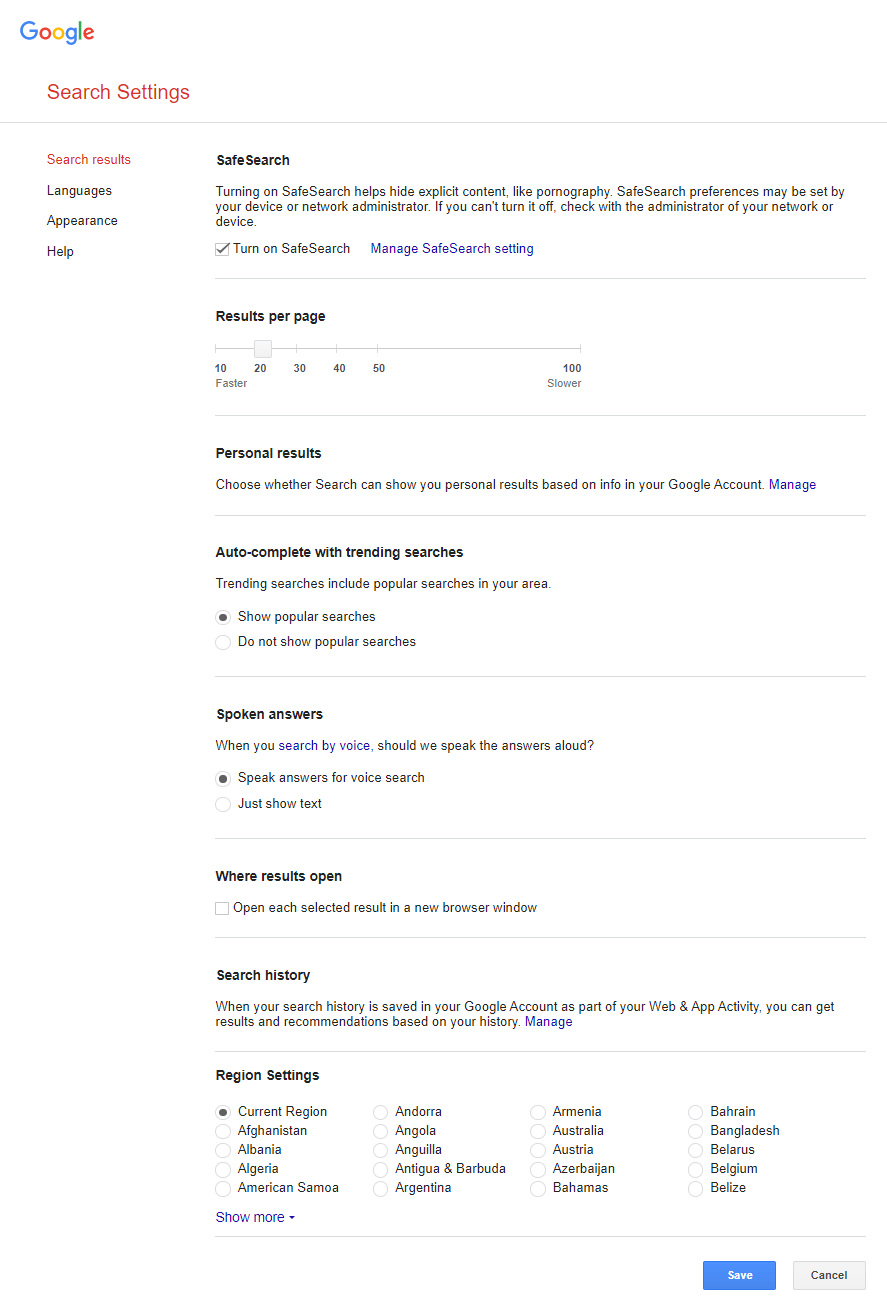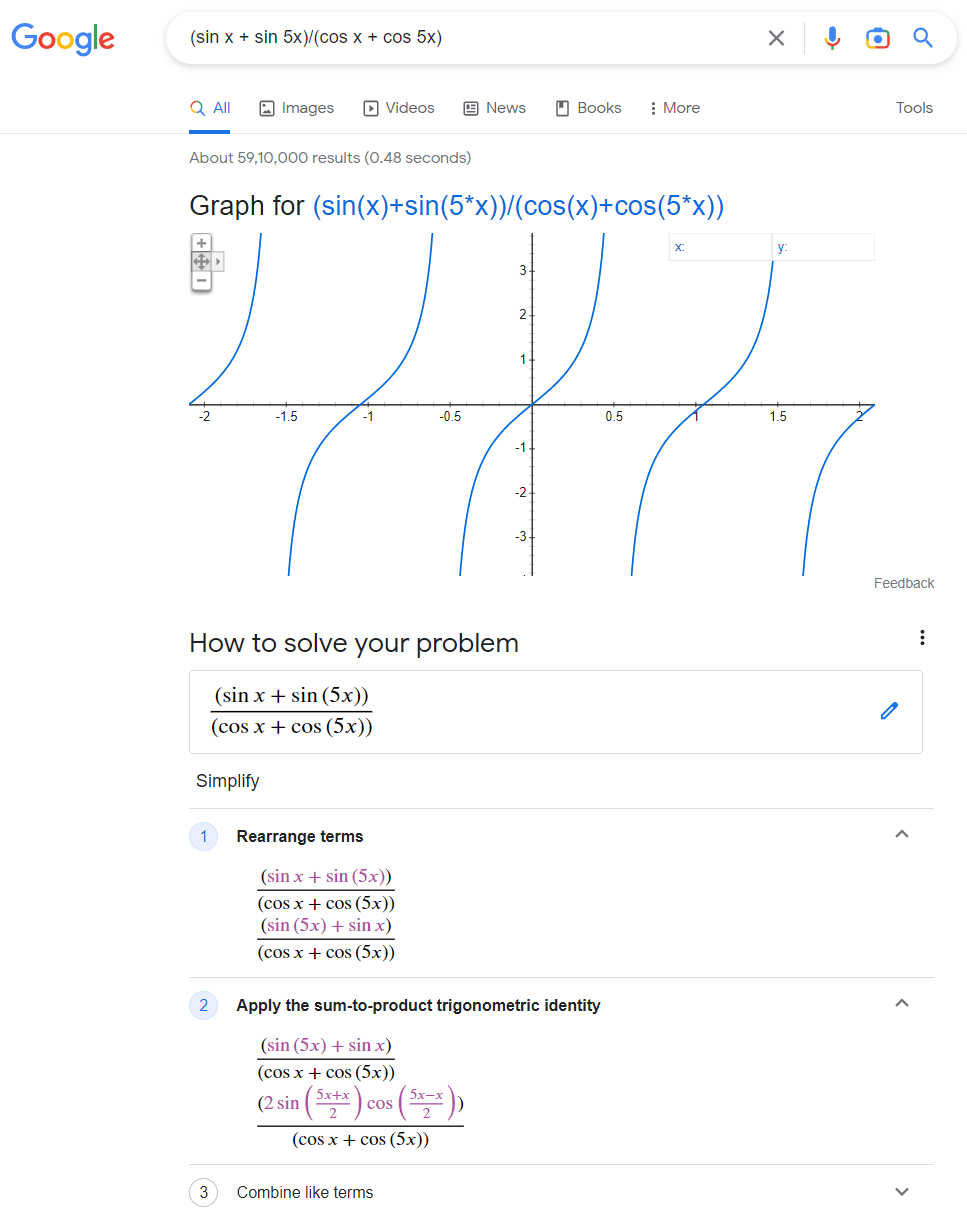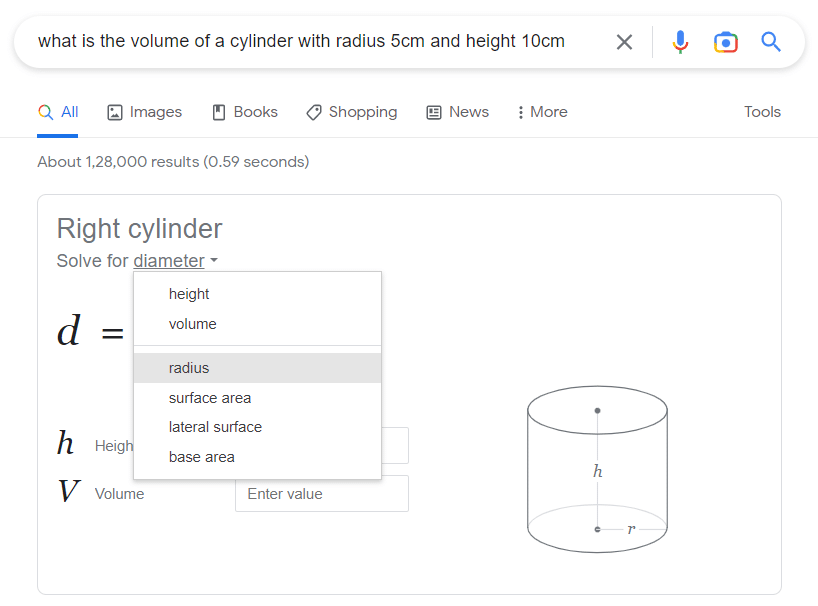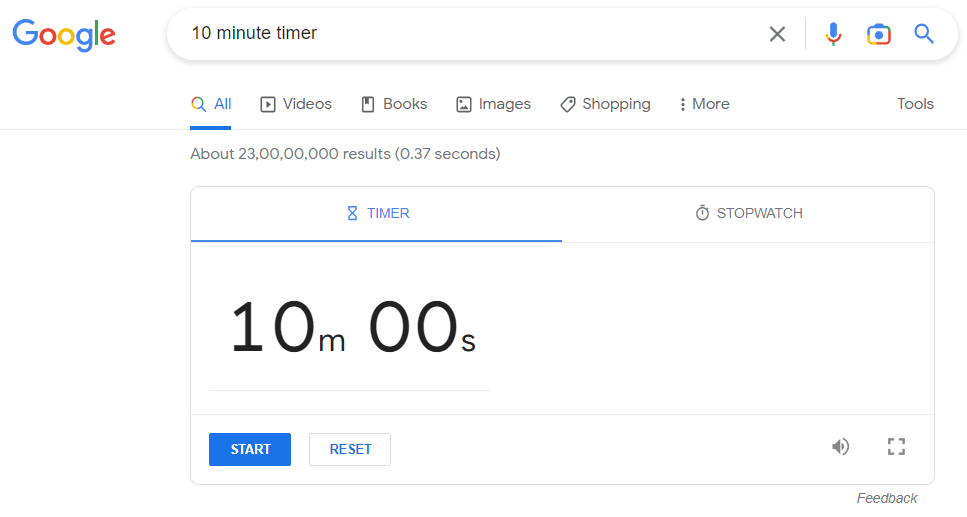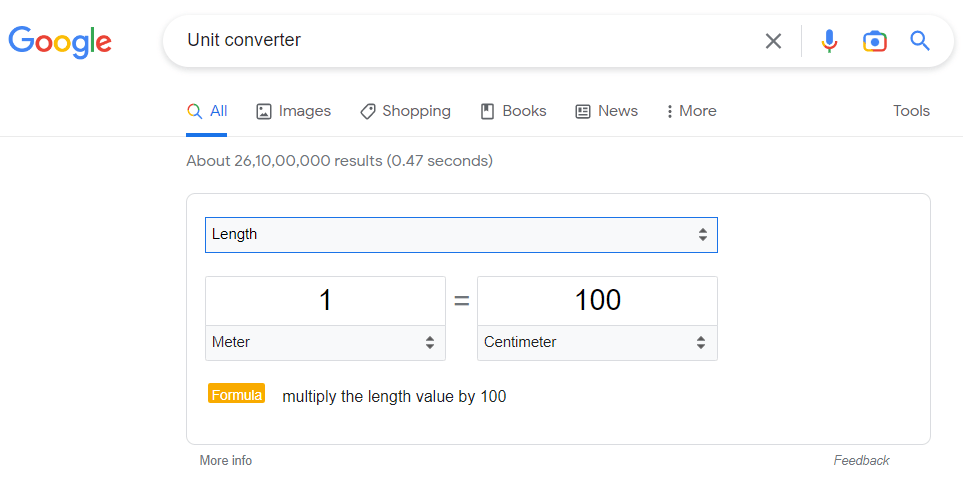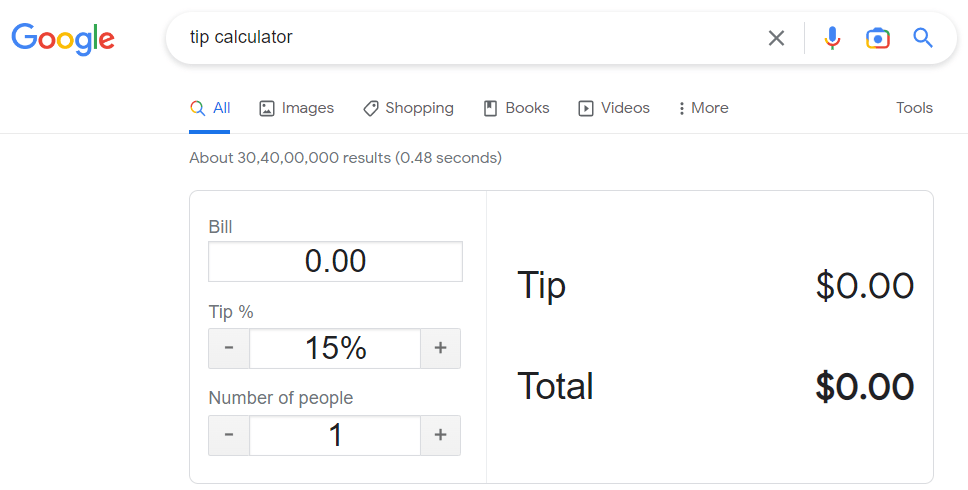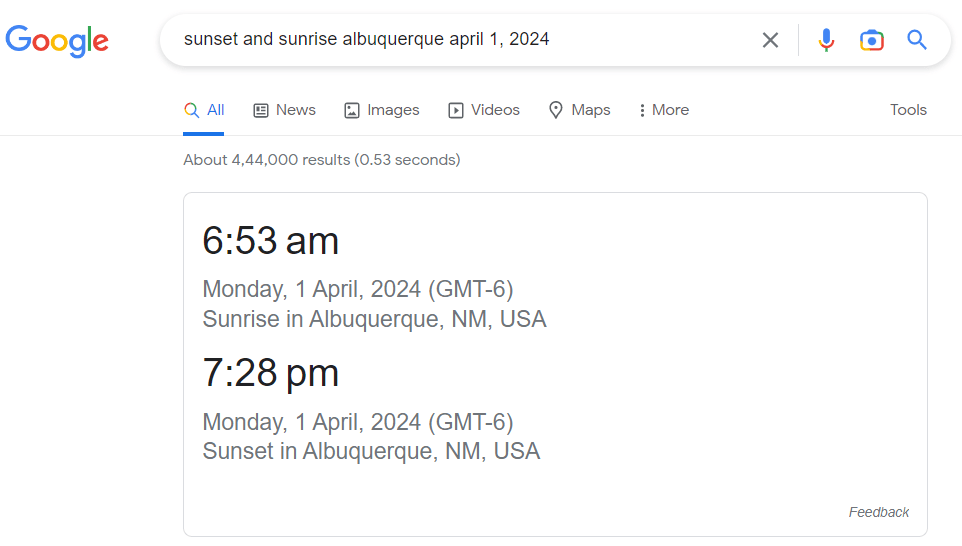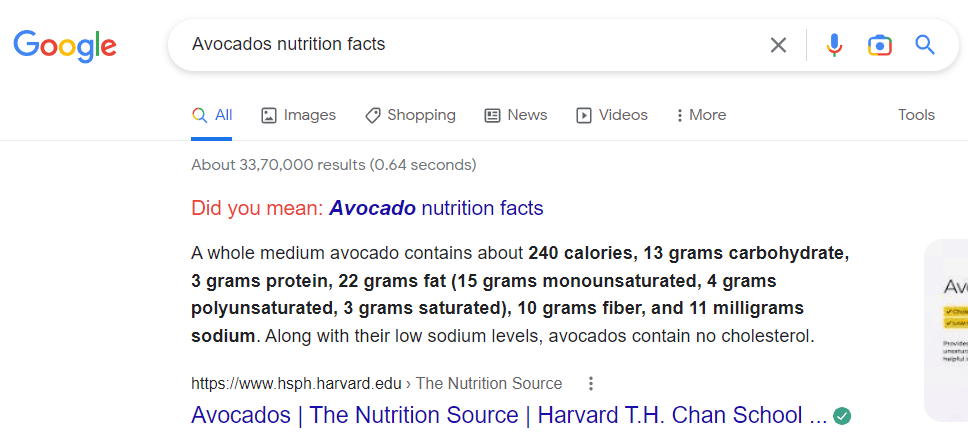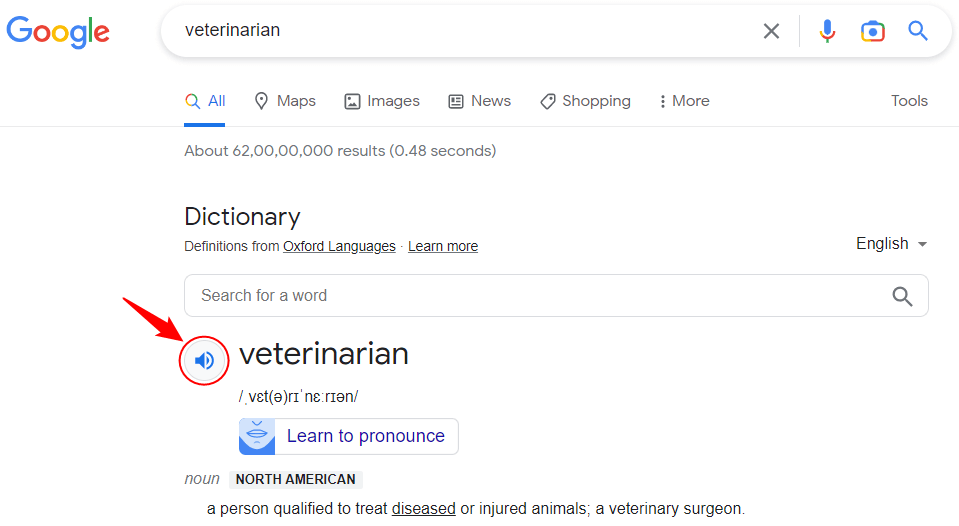Google search has come a long way since its early days. Searching on Google is not just about entering words into a search bar and hoping for the best. Some Google Search features and functions can help you get more out of your search results. There are several ways to customize, optimize, and fine-tune a search query to get the best possible outcome. We have compiled 55 tips, tricks, and hacks to take your Google searches to the next level.
If you want to explore the best of the web, do not forget to check out these 350+ most useful and amazing websites on the internet.
Basic Tips for Google Search
1. Use the Right Keyword to Get the Right Result
Using the right search keywords always brings the right results. If you don’t, you might not get the results you’re looking for. Also, you should avoid using question words, prepositions, articles, auxiliary verbs, punctuation, etc., in your keywords. For example, using ‘windows keyboard shortcuts pdf‘ is better than ‘download the pdf file of keyboard shortcuts for windows‘.
You can also try using Google’s Suggested Searches to get ideas for other keywords. If you still don’t find what you want, rephrase your query or use different keywords.
2. Search for an Exact Phrase or Word
To search for an exact phrase or word on Google, enclose it in quotation marks. By surrounding your search query with quotation marks, you can tell Google to return results that match your exact phrase.
For example, if you want to search all the websites where a particular phrase “history of the UK government” appears, enclose your search keywords within double quotes. When you do so, Google will give results that contain that phrase or keyword.
3. Search for a Specific Letter or Number
You can also search for a specific letter or number across the web. Just put a period (.) before your search query. For example, if you want to find all the available information about the letter ‘A‘, and the words that start with ‘A‘, you would search for ‘.A.’ You can also use this technique to find a specific number.
4. Search by Voice
I don’t remember using a voice command to search on Google. However, if you like, you can use your voice to search for something on Google. Click the microphone icon in the search box and answer your query. The feature is available in Chrome for desktop and mobile. You can also search by voice using the Google app on your Android device. Do not forget to check out our list of 700+ Google Assistant voice commands to learn more.
5. Search by Image
Google’s Search by Image is a Reverse Image Search engine. It is a handy tool that allows you to search the web using an image instead of a text query. All you need to do is upload an image or enter the URL of an image, and Google will show you all the websites where that image appears. You can also use Search by Image to find similar images or discover new and related images. The feature is available on desktop and mobile versions of Google Search.
To search for similar or related images, go to the Google home page and click on Images.
The Google Image Search page will open. Click on the Camera icon located in the search bar. Now you can upload your image or paste its URL to make a reverse image search. Once you click Search, Google will show you all the images matching your criteria. 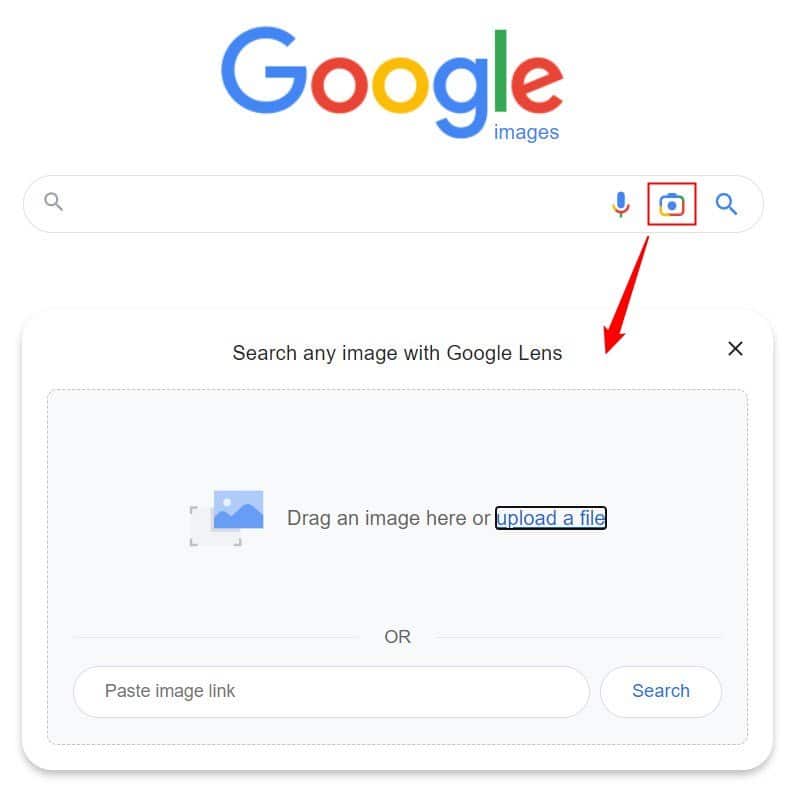
It’s easier to use Search by Image or Google Lens on smartphones because you only need to tap the camera icon next to the microphone icon to search for a related image.
6. Use Google’s USA Version
By default, Google’s results are customized according to the country you search from. If you want to use the USA or NCR (no country redirect) version of Google, you can access it anywhere. Earlier, it was possible to access Google.com instead of your local version (google.co.in, for example) by going to google.com/ncr. But now it doesn’t work anymore. The good news is you can still use the USA version of Google via the following link:
https://www.google.com/webhp?pws=0&gl=us&gws_rd=cr
A Chrome extension called Google & YouTube NCR lets you do the same.
7. Enable Safe Search
Google’s Safe Search feature can help you keep your kids safe online. When enabled, it will filter out explicit results from your search results. That means no more accidentally stumbling across nudity or other offensive content. You can also set it to ‘strict‘ mode, which will be even more restrictive. You can add certain keywords that you always want to be filtered out. Once enabled, Safe Search will work across all of Google’s services, including Image Search, YouTube, and Maps.
To turn on Safe Search, click on the Gear⚙️icon in the top right-hand corner of the screen, select Advanced Search, and click on the toggle next to Safe Search.
8. Use Google’s Advanced Search Options
Advanced Search options are meant for those who want more control over their search results. Advanced Search lets you narrow your search by language, region, file type, date, website, or region.
Suppose you enter the query ‘United States history‘ into the regular Google search bar. Your results would likely include a mix of websites, articles, books, etc., many of which might not be relevant to your needs. You can then go to the Advanced Search page for that search keyword and specify that you’re looking for websites, published within the last year (under the Last update tab), and containing the keyword ‘Founding Fathers‘ (under the Find pages with… section), and so on. Finally, click the Advanced Search button, and our results will be more targeted and relevant.
So, next time you start a Google search, check out the advanced options by clicking the Gear⚙️icon in the top right-hand corner of the search result page and selecting Advanced Search.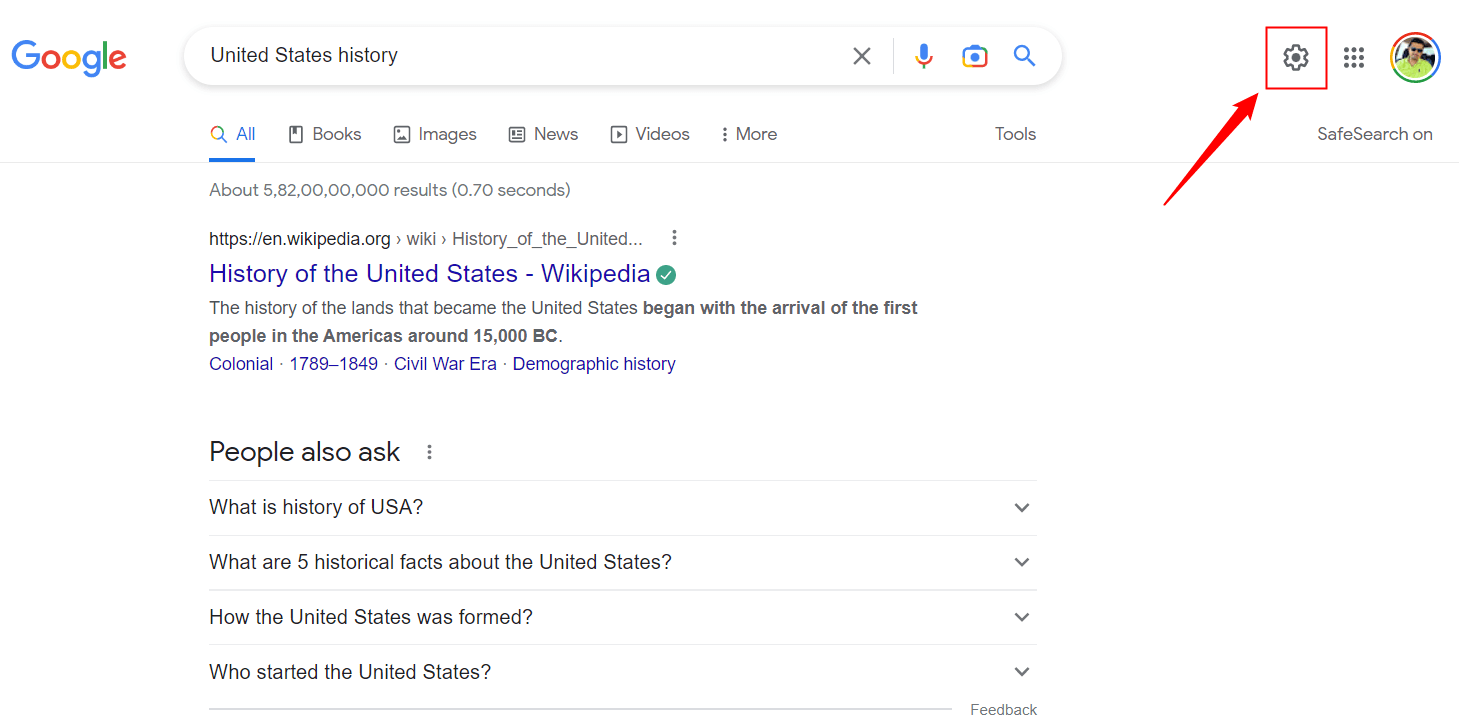
Now, you’ll have the options to help you fine-tune your search results.
9. Google Advanced Image Search
You can also use the Advanced Image Search options while searching for images to specify the image file type (JPEGs, GIFs, PNGs, etc.), image size, aspect ratio, colors in the image, and specific website where they should be located.
To access the Advanced Image Search options, search for an image, click the Gear icon in the top-right corner of the search results page, and select Advanced Search. You’ll then be able to define the parameters.
You can also use [keyword] image type as a syntax to search for images in a specific format. For example, if you want to download Spiderman’s transparent image, use ‘spiderman png transparent‘.
1o. Narrow Down Image Results by Size, Color, Time, and Type
While searching for images on Google, you can filter your results by image size, color, image type and dominant color, usage rights, etc. This allows you to find the perfect image for your needs more easily. To narrow down and customize your image results on Google, type your query and press Enter. Then click Images > Tools and add the filters.
11. Filter Video Results by Duration, Time, Quality, and Source
Google Search offers a variety of options for filtering video results by duration, time, quality, and source. This can be helpful when you’re looking for a specific type of video or want to find the best possible version of a particular video. To filter video results in Google Search, enter your query and select Videos. Then, click on the Tools option just below the search bar. This will bring up a new set of options for filtering your results. You can now filter videos by duration, time, quality, or source. Select the option that best fits your needs, and your results will be updated accordingly.
12. Customize your Google Search Experience
To further customize your experience, you can tinker with your Google Search Settings. You can choose how many results you want to see per page, and you can also select the SafeSearch filter which will remove any graphic or explicit results from your search. You can also make Google show you personalized results based on the info in your Google account.
13. Use Google’s Search History to Track Your Searches
Google’s search history feature lets you view all your past searches chronologically. You can also use the search bar at the top of the page to find specific searches. If you want to delete a particular search from your history, click the ‘✖‘ icon. The search history feature can be a helpful way to keep track of what you or anyone else using your account searched for in the past. It can also help you troubleshoot if you’re having difficulty finding something on Google.
- To view Google’s Search History page, click the Apps icon or your profile image in the top-right corner of Google’s Home page.

- Then click on Data & privacy.
- On the next page, click on My Activity under the History settings.
If you use an Android device, go to Settings > Google > Manage your Google Account > Data & privacy > History settings > My Activity.
14. Use Google Search Keyboard Shortcuts
Different keyboard shortcuts for Chrome can improve your productivity while using Google Search.
- Alt + D or Ctrl + L or F6: Clear the address bar to perform a new search.
- Ctrl + E or Ctrl + K: Use this shortcut to clear the address bar so you can kick off your search immediately.
- Down arrow + Shift + Delete: Remove search query predictions from the address bar.
- Search engine name + Tab: Search using a search engine of your choice.
- Type a search query + Alt + Enter: Search for something in a new tab.
15. Search Highlighted Text Using Different Search Engines
If you are a Google Chrome user, you can use an extension named ‘Simple = Select + Search‘ to improve searchability. You can choose from 40+ search engines. Having added this extension to your Chrome browser, highlight text from a web page. Then right-click the selected text and choose the Search ‘selected text’ option from the context menu. You can then search using a different search engine.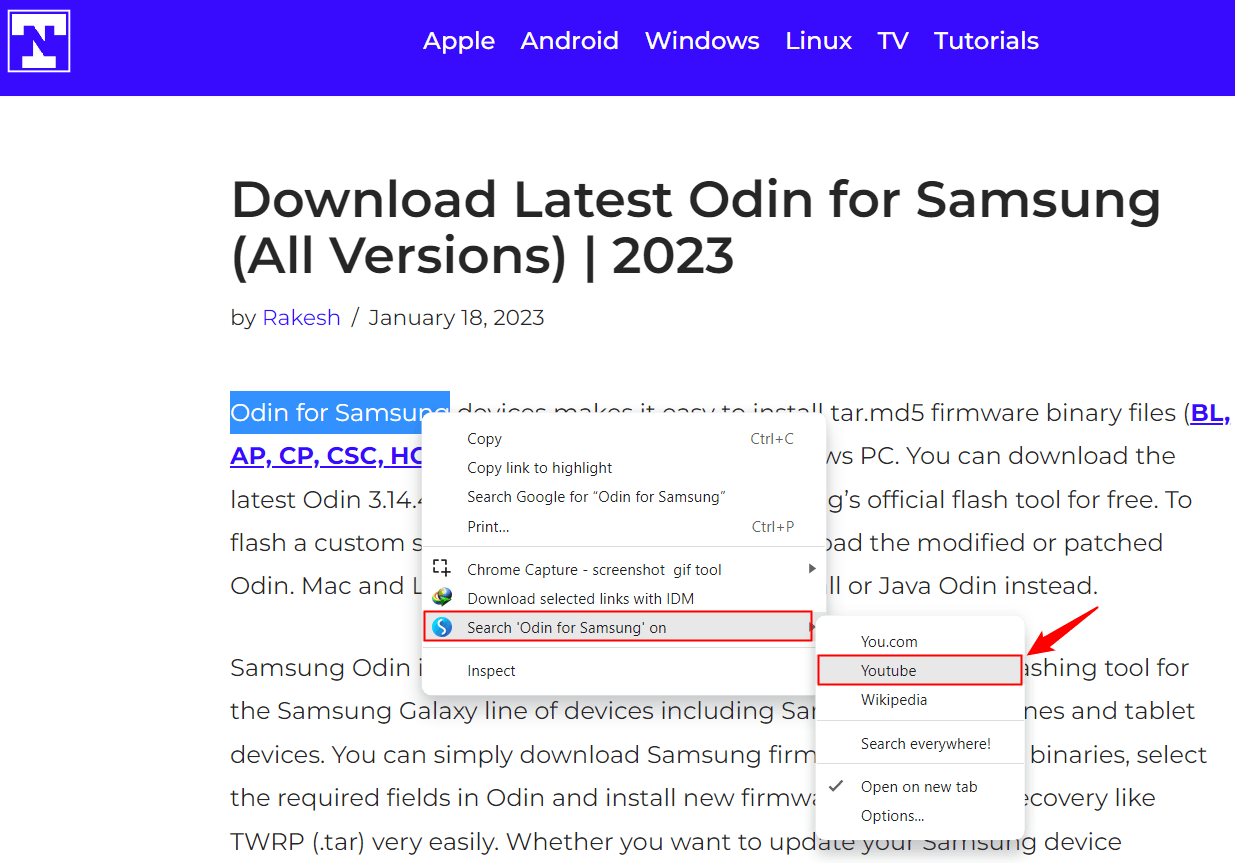
Google Search Tricks to Get Info Quickly
Besides the basic tips described above, there are a bunch of advanced tricks you can use while using Google search to learn things, calculate numbers, convert units, and get real-time information quickly. If you are a student, you might find the following Google Search tips useful.
16. Do Quick Calculations in Your Browser
Google calculator can perform a variety of mathematical operations right in your web browser. You can use it to add, subtract, multiply, divide numbers, solve equations, calculate fractions, etc.
- Arithmetic
- Functions
- Value of physical constants
- Base and representative conversion
Type ‘calculator‘ in the search box or URL bar and hit the Enter key to access the online calculator. Alternatively, you can type the mathematical expressions directly in the search box to get answers. For example, if you want to find 30% of 999, you can type it directly into the search bar. Similarly, to multiply 12345 by 12345, you can use ‘12345*12345‘ or ‘12345×12345‘.
Syntax: [number] [operator] [number]
17. Graph Complicated Equations Quickly
Besides a basic calculator, the Google search box also has tools to graph complicated equations. The tool supports problems related to Trigonometric, Exponential, Logarithmic, and 3D graphs. For example, enter ‘(sin x + sin 5x)/(cos x + cos 5x)‘ in the search box to get a step-by-step solution.
18. Geometry Calculator
Google Geometry calculator can be used to calculate the area, perimeter, circumference, law of sines and cosines, hypotenuse, perimeter, Pythagorean theorem, and volume of shapes such as circles, rectangles, 2 and 3-dimensional curved shapes, platonic solids, polygons, prisms, pyramids, quadrilaterals, and triangles, cubes. You can also use this tool to calculate the surface area and volume of more complex shapes such as spheres and cylinders.
You can either search for a formula like ‘area of a circle with diameter‘ or type your problem as follows:
- The formula for a rectangle
- Find the diameter of a sphere whose volume is 425 liters
- a^2+b^2=c^2 calc a=4 b=7 c=?
- What is the volume of a cylinder with a radius of 5cm and a height of 10cm?
19. Use a Stopwatch or Timer
Google also has a stopwatch tool. Just search for ‘stopwatch‘ in Google and you can use it.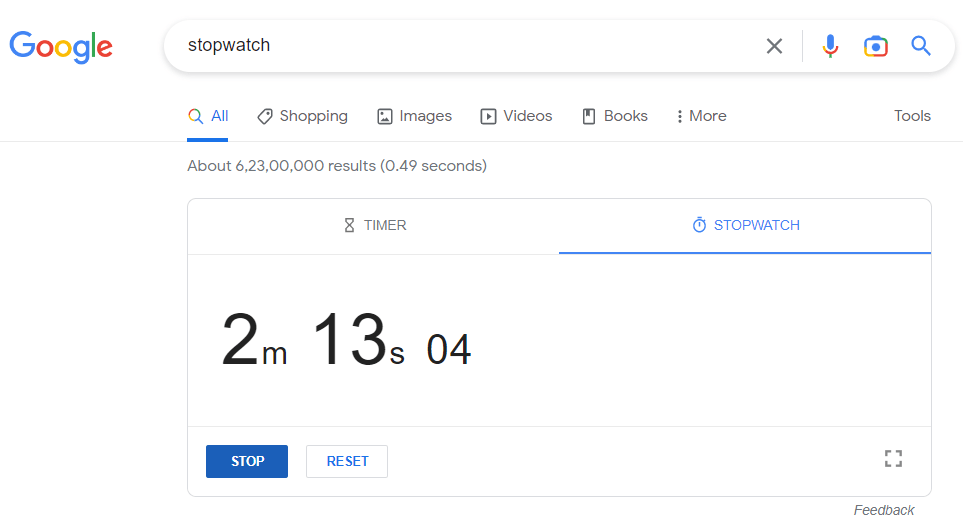
20. Timer
If you need a timer, you can quickly launch a timer on your mobile or web browser while using Google. Just search for ‘timer‘, and you’ll have a 5-minute timer. You can customize the timer duration by using [length of time] timer. Examples:
- 2-minute timer
- 10-minute timer
- 15-minute timer
21. Convert Any Units Quickly
You can access a unit converter from the Google search bar by typing in ‘unit converter‘ followed by the desired conversion. Google unit converter can be used to convert between units, including length, mass, area, currency, power, pressure, digital storage, energy, volume, fuel economy, data transfer rate, weight, time, speed, temperature, and more.
22. Tip Calculator
Type ‘tip calculator‘ into the search bar, and the first result will be a simple calculator that lets you specify the bill amount, tip percentage, and the number of people splitting the bill. You can also adjust the currency for international travelers.
23. Find Sunrise and Sunset Times
You can find the time of sunrise or sunset in a specific city and date by typing your query in the Google search box in the following formats. To find the sunrise or sunset time in your location, simply search for ‘sunrise‘, ‘sunset‘, or ‘sunrise and sunset‘. You don’t need to type your location because Google knows it already.
You can try the following variations to get the sunrise and sunset times for a particular location, time, or both.
- sunrise, london
- sunrise and sunset new york
- sunset albuquerque april 1, 2024
24. Get Weather Information
Enter ‘location+weather‘ or ‘weather+location‘ (London weather, for example), or ‘weather:location‘ in the search box, and Google will give you weather alerts and forecasts for that location.
25. Search for Flights and Trains
Are you looking for flights or trains between two destinations? Google search will help you find a list of flights from various airlines. You can filter your results by price, duration, stops, and more. Once you’ve found the perfect flight, you can book it directly from the search results page.
To search for flights or trains, use keywords like ‘london to paris flights‘ and ‘venice to amsterdam trains‘. You can also search for flights by typing ‘flights‘ in the search box.
26. Check Flight Status
Type the airline and flight number in the search bar, and Google will show you up-to-date information on the flight’s status.
Search for ‘flight status‘ on Google and fill in the required fields like origin, destination, and airline. You can also click the Flight number tab under Flight status and enter the flight number to check its status. Alternatively, you can directly search for a flight in the following formats:
- Airline name + Flight number: AA 293
- Airline name + Origin + Destination: AA DEL JFK
27. Locate Yourself
Search for ‘where am I‘ and Google will return with your live location on the map, the name of the place, and its ZIP code.
28. Find Nutrition Facts
You can also check the nutrition facts for a food item on Google. Just use syntax like [food item] nutrition or [food item] nutrition facts in the Google search box to get facts including calories, fat, cholesterol, sodium, carbohydrates, protein, and more.
29. Get Live Sports Scores
It’s easy to get live scores of your favorite sports team on Google search. Search for [team 1] vs [team 2] on Google to check the live score. For example, to get information about a match between the Arizona Cardinals and the Atlanta Falcons, use ‘arizona cardinals vs atlanta falcons‘ as the keyword.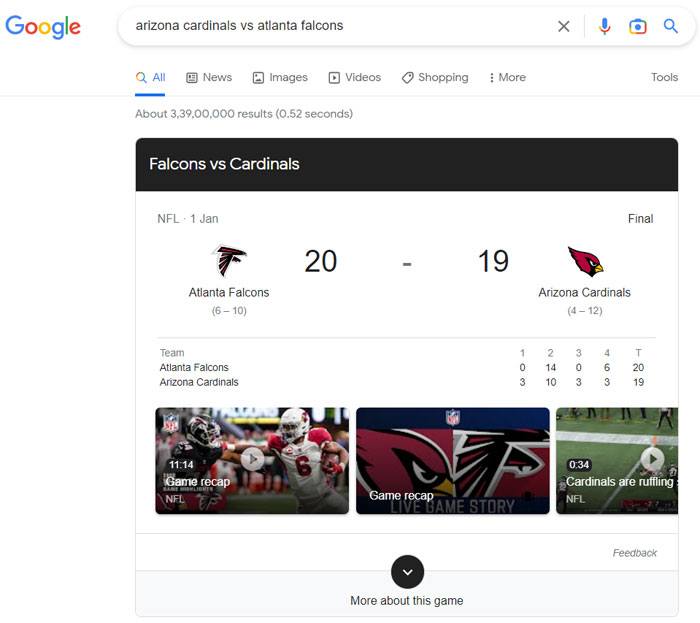
30. Search for Places Near You
If you want to find an organization, institution, shop, service, or place near you, use your keyword followed by ‘near me‘ or ‘nearest + keyword‘ to get search results.
Examples:
- jeep service centers near me
- vegan restaurants near me
- nearest atm
- thai food near me
31. Get Stock Information
If you want to check stock information on Google, type in the stock ticker symbol of the company, like ‘googl‘ (Google), ‘msft‘ (Microsoft), ‘tsla‘ (Tesla), etc., in the search box. You’ll get real-time quotes and other relevant data to help you make investment decisions. You can also search Google for [company name] stock, stock:[ticker symbol] or simply to Google Finance.
32. Use the Google Translate Tool
You can quickly access the Google Translate tool by typing ‘translate‘ in the search box. Another way to translate text on Google search is to type translate [keyword or sentence] to [language]. For example, if you wanted to translate “Hello, how are you?” into French, you would type ‘translate “hello, how are you” to french‘ into the search bar.
33. Get Directions
Google Search also has a built-in tool to show you directions. Just search for ‘directions‘ in the search box, enter the starting point and destination, and you’ll have a mini-map showing the directions, distance, estimated time, available routes, etc. You can also use keywords like ‘directions from new orleans to houston‘ and ‘directions from my place to las vegas‘.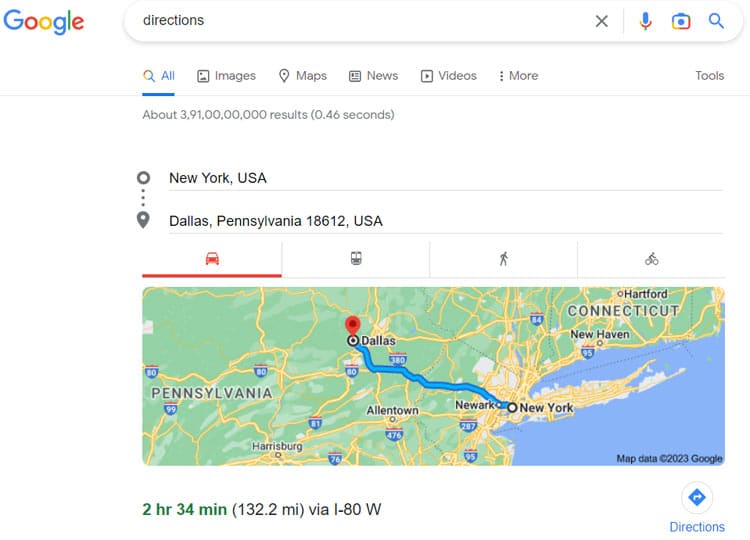
34. Find ZIP Codes for Places
You can easily find the ZIP code for any area or city on Google search using keywords like ‘princetown, new york zip code‘ or ‘connaught place zip code‘.
35. Find Your IP Address
If you want to find your IP address, Google can get it for you. Just search for ‘what’s my ip‘ or ‘my ip address‘.
36. Check Spelling
If you don’t know or remember the spelling of a word, Google can be a helpful resource. To check the spelling of a word, type the word into the search bar and see what comes up.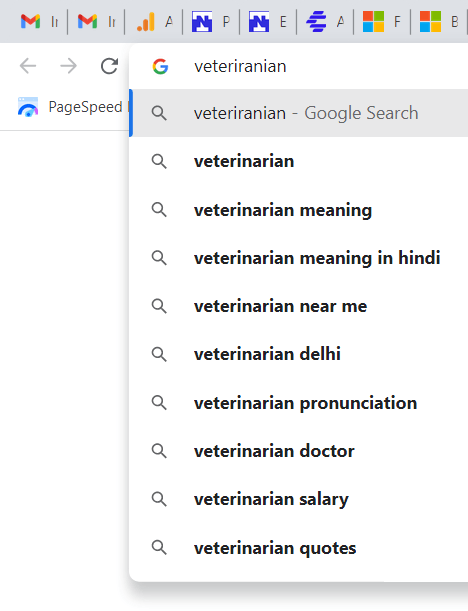
37. Check Pronunciation
Similarly, if you’re unsure about pronunciation, type a word in the search box and press the Enter key. Click the speaker icon next to the word to hear it spoken aloud. You can also search for ‘word + pronunciation‘ in the search box to get the result.
38. Lookup for Area Code
This is a great way to find out where a call is coming from if you don’t recognize the number. Enter the area code into the search bar and hit Enter. A list of results will appear, including the city and state for the area code you searched. To find out about area code 646, search for area code 656. Similarly, if you don’t know the area code for a place, type area code [location] in the search box.
Use Google Search Operators
Search operators are special characters and terms you can add to your search queries to filter your results on Google and get more specific results. These operators can narrow your search results to match your query.
39. Exclude Words from your Search
If you want to search for a term but exclude certain words or things in the results, you can use the minus sign (-).
-[keyword to exclude] [keyword to include]
[keyword to include] -[keyword to exclude]
For example, if you’re searching for information on smartphones but want to exclude Samsung smartphones from the search results, you would search for ‘smartphones -samsung‘. You can also use this search operator to exclude a specific website from search results. If you want to remove Amazon.com from the results, use ‘samsung galaxy s24 – amazon‘.
40. Include Additional Terms in your Search
With this Google search trick, you can include additional terms in your search. If you want to ensure that your results include a certain word or phrase, you can use the plus sign (+). For example, if you’re searching for information on cats and want the results to include the word ‘kittens‘ too, you would search for ‘cats +kittens‘.
41. Use ‘OR’ between your Search Terms
The ‘OR‘ search operator allows you to search for multiple keywords. It is useful when you don’t know which keyword will yield the best results. You need to separate your keywords with OR (capitalized). For example, if you wanted to find information on cats or dogs, you would search for ‘cats OR dogs‘. If you don’t use OR in capital letters, Google will take it as part of your keyword.
42. Combine Search Terms with AND
‘AND’ is a Boolean operator that combines two or more search terms. For example, if you were searching for information on cats and dogs, you would use ‘cats AND dogs‘ as the search query. This would return results that contain both ‘cats‘ and ‘dogs‘.
43. Use * as a Wildcard to Fill in Missing Info
When you use the asterisk (*) on a Google search, it acts as a wildcard and will return results for any word that matches the part of the word that comes before or after the asterisk. Google uses an asterisk (*) as the wildcard character and for proximity searches.
For example, if you search for ‘test*‘, you’ll get results for ‘testing‘, ‘tests‘, and ‘tester‘, etc. Similarly, if you don’t remember the first, middle, or last name of a famous person, the full name of a movie, or part of some title, saying, or lyric, etc., you can use an asterisk (*) as a placeholder for the missing letters or words. Google will retrieve the missing
Try the following examples:
- steve*
- everybody knows that the dice*
- humpty dumpty * a wall
44. Use ‘..’ to Search within Numeric Ranges
If you’re looking for a specific number within a range of numbers, the best way to search is by using the ‘..‘ (2 periods) operator. For example, to find all numbers between 10 and 20, you would use the following query: 10..20. This would return all results within that range.
Try the following examples:
- 10..20
- star wars 1977..2015
- wwdc video 2015..2023
- samsung phones 2021..2023
45. Use ‘@’ to Search Social Media
You can easily search for someone on social media using ‘@‘ before a word. For example, you can use ‘@technastic‘ to find our website’s social media pages.
46. Get the Definition of a Word
Using the “define:” search operator to find the definition of a word on Google. For example, if you enter “define:epistemology” into Google, the first result will be the definition of the term.
47. Find the Origin and History of Words
If you want to find the origin and history of a word, you can use ‘etymology:‘ as a search operator followed by the word. For example, to check the origin of the word ‘religion’, you can search for ‘etymology:religion‘.
48. Limit Search Results to a Specific Website
You can also use search operators to find results from a specific website. For example, if you want Google to display web pages from Technastic.com, you can use ‘site:technastic.com‘. Similarly, to find all instances of a certain topic (Google, for example) on this website, you can use the ‘site:technastic.com google‘. This operator helps you find websites using a specific TLD (top-level domain). For example, if you want to search for veg curry recipes from websites in India, you can use ‘veg curry recipes site:.in‘.
49. Search for Keywords within a URL
Two search operators let you search for terms in a URL. For example, to find all the URLs containing ‘Google’, you can use ‘inurl:google‘. Similarly, to search for all Google URLs that contain ‘Android’, you should enter ‘allinurl:google android‘ in the search bar.
Other examples:
- allinurl:technastic
- allinurl:technastic.com android
50. Search for Specific Words in the Title
To find web pages that have specific word/words mentioned in their titles, you can use the ‘intitle:‘ search operator. For example, if you want Google to list all pages that contain “Windows 11” in their title, you would enter ‘intitle:windows 11‘ in the search box. Similarly, you can use ‘allintitle:‘ as in ‘allintitle:google android‘ to file all web page titles containing ‘Google’ and ‘Android’.
51. Find Specific Words on Web Pages
The ‘intext:‘ and ‘allintext:‘ search operators can be used to find all the instances of a particular word or phrase on a web page. This can be useful for locating specific information on a page or finding all instances of a particular word or phrase on a site.
Examples:
- intext:google
- allintext:google android
52. Search for Pages Related to a Specific Website or Topic
The ‘related:‘ search operator can be used to find web pages similar to a specific website. Take a look at the following example:
- related:amazon.com
53. Narrow your Results by File Type
While searching for files, you can narrow down the results using operators like ‘filetype:‘ and ‘ext:‘. Try the following examples:
- diet plan filetype:ppt
- adb shell commands ext:pdf
54. Find Results from a Certain Source
The ‘source:‘ search operator tells Google to show results from only a specific website or domain. For example, if you wanted to find information about Google from The Verge, you would use the following search query: ‘google source:theverge.com’.
55. Convert One Unit to Another Using ‘in’
While Google Search has a built-in unit converter, there is also a simple search operator to convert one unit into another quickly.
- 560cm in inches
- $500 in gbp
- hello in spanish
56. Find Information about a Movie
Google search also lets you find detailed information about movies. Just use “movie:” followed by its name to find its showtimes, cast, IMDB rating, user reviews, and OTT platforms where it can be watched. Example: movie:shawshank redemption
To discover the hidden Google Search features, do not forget to check out the following articles:
With these tips and tricks for Google Search, you now have a comprehensive cheat sheet to help enhance your search experience. They will surely help you access information quickly and easily. From advanced operators to keyword modifiers and extensions, we discussed everything to help you find the results you need faster than ever before.
Read Next: 20 Best Google Chrome Flags You Must Try
